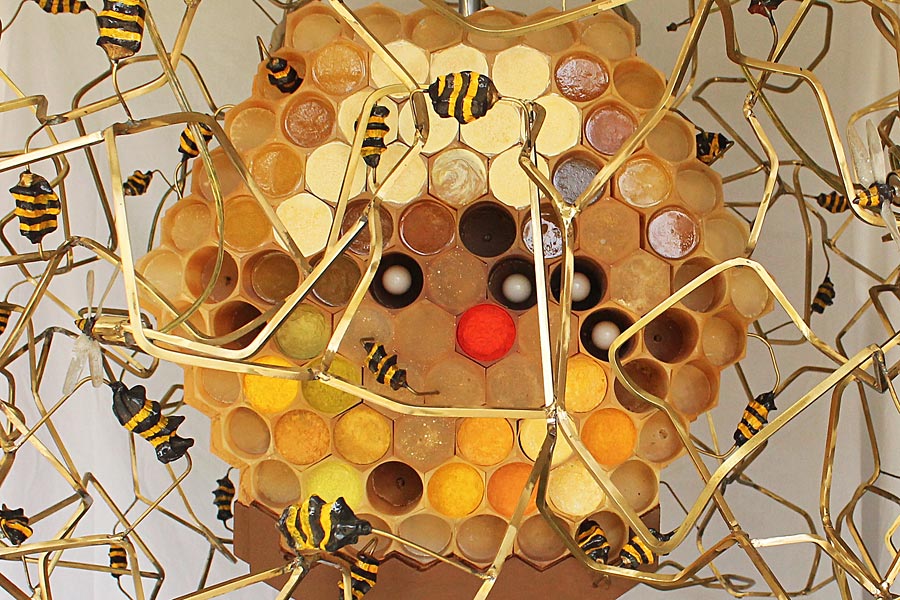Notebook sketch. Colored pencil
pollinators
news: solo show announcement /
Detail of "The Beekeeper," 2015. Kinetic sculpture made with steel, cast resin, brass, electronics, wood and paint. Approximate dimensions are 60"(W) x 132" (H). Kelly Heaton
I am pleased to announce that my latest body of work, "Pollination," will open on September 12 at Ronald Feldman Fine Arts, 31 Mercer Street, NYC. The show addresses many facets of pollination as a fertile exchange, including bees, commerce, human relationships, spirituality and technology. Works include large-scale sculpture, kinetic sculpture, works on paper and perfume. A public reception will be hosted at the gallery on September 12 from 6 - 8pm. The show runs through October 24.
For more information, please sign up for my mailing list or contact Ronald Feldman Fine Arts: (212) 226-3232.
open studio: building the throat chakra /
The Beekeeper is a large sculptural work-in-progress, to be exhibited as part of Pollination in September 2015. It is comprised of seven or eight chakras. Here, I am building the throat chakra out of brass. In the center (4th image) is a low RPM / high-torque motor that turns the throat, pineal and heart chakras. The pineal and heart chakras are not shown in these images, but will be featured in later posts.
pollinators: death to drones /
As cold weather approaches, the worker bees (female) expel the drones (male) in preparation for winter. Drones can be identified by their larger eyes that meet in the center, as well as their larger black abdomen. The smaller, active bees are the females working to remove the dead. Bees in this role are known as "undertakers" for the hive. Nearly all of the bees in this video are dead or dying drones on the ground in front of their once nurturing hive. In another month or two, the remaining worker bees will form a tight cluster around the queen, vibrating their wings to keep the colony warm (a remarkable 94 - 98 degrees F in the center); and rationing their honey supply until Spring.
This video also shows signs of hygienic behavior - notice the drone larvae which appear affected by Varroa mites. I am doing a mite count to see if I need to treat this hive.
September 2014 / Clarke County, Virginia
pollinators: our bees, ourselves /
Excellent article in the New York Times: http://nyti.ms/1zDc7Vw
Image: Katie Scott. Article: Mark Winston. Source: New York Times
God Will Save Me
A terrible storm came into a town and local officials sent out an emergency warning that the riverbanks would soon overflow and flood the nearby homes. They ordered everyone in the town to evacuate immediately.
A faithful Christian man heard the warning and decided to stay, saying to himself, “I will trust God and if I am in danger, then God will send a divine miracle to save me.”
The neighbors came by his house and said to him, “We’re leaving and there is room for you in our car, please come with us!” But the man declined. “I have faith that God will save me.”
As the man stood on his porch watching the water rise up the steps, a man in a canoe paddled by and called to him, “Hurry and come into my canoe, the waters are rising quickly!” But the man again said, “No thanks, God will save me.”
The floodwaters rose higher pouring water into his living room and the man had to retreat to the second floor. A police motorboat came by and saw him at the window. “We will come up and rescue you!” they shouted. But the man refused, waving them off saying, “Use your time to save someone else! I have faith that God will save me!”
The flood waters rose higher and higher and the man had to climb up to his rooftop.
A helicopter spotted him and dropped a rope ladder. A rescue officer came down the ladder and pleaded with the man, "Grab my hand and I will pull you up!" But the man STILL refused, folding his arms tightly to his body. “No thank you! God will save me!”
Shortly after, the house broke up and the floodwaters swept the man away and he drowned.
When in Heaven, the man stood before God and asked, “I put all of my faith in You. Why didn’t You come and save me?”
And God said, “Son, I sent you a warning. I sent you a car. I sent you a canoe. I sent you a motorboat. I sent you a helicopter. What more were you looking for?"
open studio: fake food for pollinators /
Media: fabric, cloth, wire and paint. Work in progress, Kelly Heaton, 2014
pollinators: 1st look into my new hives /
The Queen of hive 2 of 2
Various images of frames in my new hives, both 1 and 2. Beautiful!
electricity: breathing motor /
An astable multivibrator controls a Darlington amplifier to drive a small pager motor. The gently rising and falling motor speed simulates breathing or other natural undulations. The addition of other control stages could add complexity, if that's what you want.
Circuit design by Kelly Heaton, 2014. If you try to build this and it does not work, I'm sorry… I am more artist than engineer. I sometimes struggle to reproduce my own circuit diagrams, but I have learned that tinkering with frustrating electronics is a great way to make new art.
This analog circuit is comprised of two parts: an astable multivibrator that creates a low-frequency square wave (left side) to switch on/off a Darlington amplifier (right side) that drives the pager motor. I have added various capacitors and a resistor to the amplifier stage. These affect the quality of the motor speed, making it turn on and off more naturally. The video shows me removing / replacing the pull-up resistor on the emitter of the second NPN transistor, illustrating its function (to provide a baseline motor speed so that the motor does not come to a complete stop, but instead undulates between a faster and a slower speed).













